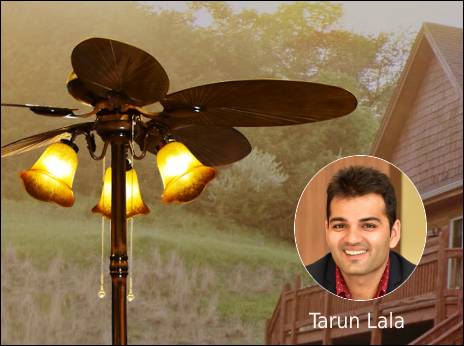
The humble fan is going high-tech!
By Tarun Lala, Director & Co- Founder, Fanzart, a luxury fan brand
August 12 2021: It is a product that has been omnipresent in every urban household over the last six to seven decades, its presence not only viewed as a necessity, but as a factor that is taken for granted; to the point where its absence would raise eyebrows. We are talking about the ubiquitous fans that permeate living spaces across the country, in both urban and semi-urban households. Even in the least affordable homes, if not a rickety ceiling fan, a table fan would find its presence, marking its irreplaceable place in the hot humid regions of our country.
The humble ceiling fan has now seen a metamorphosis over the last decade, where, not only has its physical form altered, but its mode of functioning too, especially with the phenomenal tech aided solutions coming into place. Fans are now not just functional features in a household but serve as a style statement, their presence many times adding to the decorative element. Their operations too have become hi-tech, aided by the technological solutions on offer.
Visual Appeal
While keeping well in perspective the functionality features, the new age fans come in a range of stunning forms, proving to be a virtual visual treat. The materials used in their manufacture too are varied, the blades structured in various forms where some of them draw in while not in use, to display the fan as a lighting solution with an attractive light fitting fused into it. The lighting integrated fans manifest as an arresting decorative feature, through their shapes, style and colours, with a sizeable number incorporating crystals as well as Bluetooth to facilitate remote operation.
For instance, a fan in a living or dining space can appear as a stunning chandelier, the blades withdrawn into the light fitting. The blades here feature as retractable or collapsible contraptions, where they curl up over the LED fitted in. There are also miniature fans of 22 inch diameter with vortex blades where they are designed to appear only as chandeliers. Here, the blades remain tucked inside the chandelier even when the fan is switched on and yet give the breeze. Some of the fans also come with transparent blades to visually negate their presence.
Addressing Differential Needs
Besides the physical sleek features, the tech enabled fans also cater to the differential needs of the occupant. For instance, there is a tendency to operate the fan at full speed on returning from a very warm outdoor. But this requirement alters once the body cools down. Similar pattern is evinced when turning into bed at night and later during the night, the breeze gets to be too cold. This prompts a pattern of increasing and decreasing the speed of the rotations to cater to individual needs over a period of time. And if there is more than one person sharing the same space, the breeze from the fan would need to cater to these varied individual requirements.
The tech-enabled fans alternate between faster rotations and slower rotations, thus altering the speed to keep the room temperature optimum and comfortable. The angle of the blades also alters the quantum of breeze circulated in the room. Similarly the length of the blade and its width alters the level of air circulated by the fan. The new age fans thus manipulate the level of air circulation in the room by suitably designing and altering the length and width of the blades as well as their angles.
Likewise, by altering the direction of rotation of the blades, the strength and direction of breeze is altered. For instance, when food is served, the presence of fan is required to offer a cool dining experience. Yet, the breeze directly focusing on the food served is not acceptable as this can negatively alter the dining experience. By reversing the direction of the rotation to moving clockwise instead of the customary anti-clockwise, the breeze is directed on to the ceiling and dispersed across the room.
Similar alteration in the direction of the breeze works to offer a fine solution in an air conditioned room. Given the cool air from the AC duct dropping on to the floor, sleeping in an air conditioned room could prove to be uncomfortable after a point because of the increase in chillness after a period. Reversing the direction of rotation of the blades lifts up the chill air at floor level and spreads it evenly across the room, aiding to keep the ambient temperature comfortable.
Tech Aided Sensors
The new age fans also come with sensors to detect human presence in the room, to direct the breeze in accordance. This aids in adjusting the Rotation per Minute (RPM) to reduce the air supply to sections of the room that are unoccupied, thus optimising consumption of electricity. Besides, A brushless DC or BL-DC motor is an electromagnetic motor that absorbs 70% lesser power.
With home automation becoming a popular choice, these technology-enabled fans also serve as a hub for home automation by accommodating a chip to be inserted within. The smart fan, with the embedded chip then becomes the hub to connect to and facilitates the employment of home automation solutions in a household where the conventional DC motors typically prevent their implementation and smooth operation.